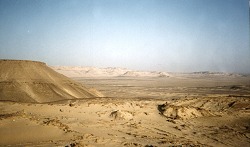
Region to the west of the Nile valley, stretching as far as the Libyan border and thus also called the Libyan desert. There are a number of oases in this region which owe their existence to the presence of large quantities of fossil water deep in the earth that comes to the surface through numerous springs. The most important oases are Bahariya, Siwa, Farafra, Dakhlah and Kharga. The Faiyum, which gets its water from an offshoot of the Nile, is not an oasis in the strict sense of the word. In Palaeolithic times the western desert was inhabitable thanks to its plentiful rainfall. Many finds dating from the later prehistoric period have also been made, such as pottery, arrowheads and millstones. Traces have also been found of cultivated plants (near Nabta, which makes it the oldest agricultural area in Africa) and of domesticated animals.
The oases are mentioned in Egyptian texts from the Old Kingdom on. Under Pepi I and Pepi II at least there were governors of the oases; their mastabas have been found near Dakhla. Later periods also frequently mention the oases, and several tombs from the New Kingdom show people bringing the products of the oases. The temple of Edfu contains a text listing a total of seven oases; in addition to the five already mentioned there is one which is not yet securely identified (probably el-Hayz) and the Wadi Natrun. The archaeological remains date from prehistoric times down to the Middle Ages; a large number of the monuments date from the Late Period and the Graeco-Roman Period in particular. Several minerals were mined in the western desert, such as amethyst and carnelian in a mine about 65 kilometres northwest of Abu Simbel.